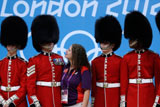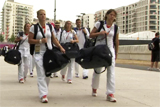Eurozone turmoil may prolong London revamp
Updated: 2012-06-29 15:08:37
( Agencies)
|
|||||||||||
LONDON - When Bill Hanway began designing a 20-25 year blueprint to revamp the area of east London that will host this summer's Olympic Games, he factored two to three recessions into his plans.
What the Aecom executive failed to foresee back in August 2003 was the failure of Lehman Brothers, or any possible eurozone implosion.
But now the severity of the downturn which began in 2007 means the revamp timeline may be extended, Hanway said. He declined to say by how much, but one source familiar with the situation said it could be five to 10 years.
"What happened in 2007 was an aberration," said the serene, shaven-headed New Yorker, who is also the brains behind a post-Olympics revamp in southwest Rio de Janeiro, the Brazilian city hosting the Games in 2016.
"No masterplan project could claim to accommodate or predict this range of economic fluctuation," Aecom's executive director of operations said, emphasising the flexibility needed to plan the 741-acre site in London's Lower Lea Valley.
In July 2005, London beats rivals including Paris and New York to host the Games, its winning bid built around the regeneration of an area of east London more famous for its noxious industries, slaughterhouses and polluted waterways.
The post-Games plan is an increasingly important factor when the International Olympic Committee (IOC) selects a host city. The now-derelict and graffiti-covered venues of Athens, which held the Games in 2004, are a reminder of why.
Final green light
The London plan is due to receive its final green light by planners on Tuesday.
Development of the east London site, the majority of which is publicly-owned, will be overseen by the London Legacy Development Corporation (LLDC), which will let venues to new operators once the Games are over and oversee the phased sale of leasehold land to housing developers.
The biggest impact of the financial crisis on the 9.3 billion pound ($14.6 billion) London Olympics project to date was a 2009 decision by the British government to fund development of the athlete's village itself rather than sell to developer Lend Lease, a deal that came with the associated risk of debt finance.
The 11 tower blocks housing 16,000 athletes and officials will be turned into 2,818 homes after the Games, work that requires the installation of kitchens, as competitors eat in communal dining halls. The site was bought by a joint venture that includes the development arm of Qatar's sovereign wealth fund for 557 million pounds in August.
Other changes enforced by the unexpectedly harsher economic climate will include a greater emphasis on job creation when the LLDC selects the future tenant for the media center once the world's press have left town, Hanway said.
The contract to operate the aquatics center and the multi-use arena as leisure venues after the Games was also packaged into a single, more financially viable, deal.
Otherwise the message was "don't panic", said Jason Prior, chief executive of planning, design and development at Aecom who oversaw the London project. "We had a long-term view and couldn't over-react to the collapse of Lehman Brothers."
Real-life SimCity
"We've always talked about the Olympic Park as another of London's great estates," he said, referring to the city's aristocratic landowners who have guarded their ancestral good fortune by taking a long-term view of real estate over several hundred years.
Like a real-life version of the computer simulation game SimCity, Aecom uses software to calculate each square meter of housing, schools, dental surgeries and outdoor parks for the area's 14,000 future inhabitants, in addition to the number of swimming pool lanes, police officers and fire stations.
The aim is to attract and retain a mixed group of residents, including the middle classes, to a wider area that is one of the most socially deprived in Britain.
"We knew this wouldn't be the next Mayfair or Kensington," said Prior. "If we create a 'nappy valley' in east London we will have succeeded," he said, referring to the popular description of areas attractive to affluent young parents.
Two primary schools, one secondary school and nine nurseries will play a crucial role in ensuring wealthier families stay. "Bluntly, parents move to be near decent schools and they act as massively important glue in communities," Prior said.
Striking a balance between housing that residents can both afford and aspire to live in was also important. There will be up to 6,870 new homes and the target is 35 percent affordable and social housing and 65 percent private housing, which includes four bedroom townhouses.
"One of the big complaints from the Mayor of Newham at the outset was that once people could afford to, they left the area," Hanway said.
"What will be interesting is what happens in 10 to 15 years when the children of young families leave home or go to university," said Sarah Elliott, Aecom's head of planning in Europe.
Medal Count |
||||
| 1 | 46 | 29 | 29 | |
| 2 | 38 | 27 | 22 | |
| 3 | 29 | 17 | 19 | |
| 4 | 24 | 25 | 33 | |
| 5 | 13 | 8 | 7 | |
| 6 | 11 | 19 | 14 | |
















